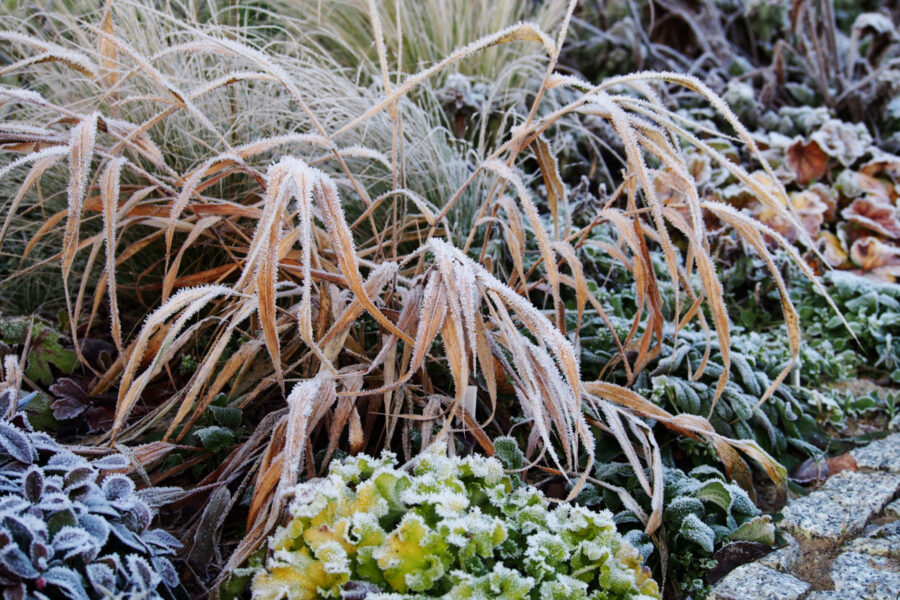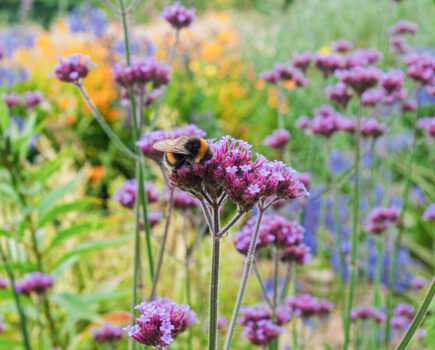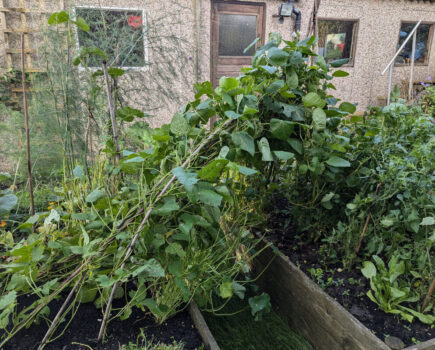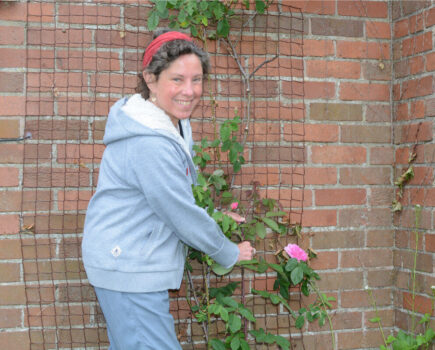Mike Palmer explains the benefits of leaving your garden standing
I love my garden at this time of year: the sweet chestnut tree in my neighbour’s garden, standing naked, towering high above a frosty lawn beneath, and my breath sending clouds of steam up into the cold November morning air as I survey the borders. Ghostly silhouettes of parchment-coloured ornamental grasses and perennials standing like sentinels; a silent sinister sky casting an eerie bruised light across the garden.
The loud, squawking arrival of a hungry blackbird shatters the winter morning’s silence, its eye cocked downwards from its vantage point on my garden seat, before fluttering down, tussling through the petrified remains of sepia-stained fallen foliage nestling at the feet of evergreen shrubs, looking for sustenance.

The vivacious verdant beauty of our summer gardens may have gone, but in its place a faded and forlorn quiet but subtle beauty, which I adore.
Many years ago, my garden was razed to the ground in late October, with grasses, perennials and the last vestiges of summer bedding felled, chopped up finely and consigned to my green ‘Dalek’ compost bins. Thankfully, I’ve learned about the importance, let alone the aesthetic appeal, of keeping much of the garden standing, wherever possible, to the benefit of me, Head Gardener, the local wildlife and, most importantly, the soil.

Protect the fertility of your garden
Cutting back perennials is part of the wonderful cycle of gardening, but its timing is a key consideration. Carried out now, as we head into erratic winter weather, exposes our precious soil to the elements. Prolonged and heavy rainfall is beneficial, but in excess, and when flood conditions prevail, it saturates the ground, soaking down through the soil and potentially washing vital minerals and important nutrients, which are integral to robust, healthy and resilient plant growth deep down and away from plant root zones. Leaving the biscuit-coloured remains of perennials and leftover leaf litter on the soil provides protection, shelter and valuable insulation for the crowns of hibernating plants and their underlying root zones.

Similarly, winter winds whipping across expanses of bare soil can cause further damage. The seemingly innocuous debris, Mother Nature’s mulch, is best left on the surface to break down and decay before being taken deep down by a ravenous clew of earthworms, where it’ll subsequently be feasted upon by a multitude of micro-organisms and invertebrates. This incredible cycle of activity nourishes the soil, replenishing valuable nutrients to aid plant growth, while opening up the soil structure, relieving compaction and optimising root growth. How incredible is that?

Easy ways to provide shelter for wildlife this winter
The good news keeps on coming! Stripping our gardens of perished perennials prematurely deprives precious wild creatures of safe and secure winter lodgings. Insects, including ladybirds, bees, and butterflies, will seek shelter and security in and among the remains of faded plants and other garden debris, under leaves or within plant stems as just one example.
Frogs and toads will burrow into the soil or find refuge in leaf litter to escape the biting cold of winter, while some reptiles, like snakes and lizards, will seek sheltered spots, such as under rocks or in cosy compost piles to hibernate until spring arrives.
Feeding our feathered friends is sadly somewhat neglected at this time of the year, but a garden left standing will provide a smorgasbord of snacks, including seeds and overwintering insects for starving songbirds. Some species, like sparrows and finches, may even roost in shrubs or trees for protection from the elements.
Last, and certainly not least, a plethora of small garden mammals, including hedgehogs, field mice, voles, and rabbits, may take advantage of the dense remains of our summer borders as a safe haven until the early stirrings of spring are apparent.

Leaving seedheads intact helps gardeners also
When I leave my borders standing over winter with the seedheads intact, aside from the odd few here and there, which I may have pillaged, I’m always astounded at the way certain self-seeded plants pop up in spring in the most perfect eye-catching manner, creating plant combinations I could only dream of. Although a little infuriating, having studied garden and plant design for a number of years, I’ve resigned myself to the fact that Mother Nature has a decidedly more artistic eye than my own, but I strive to observe and emulate her immaculate creativity.
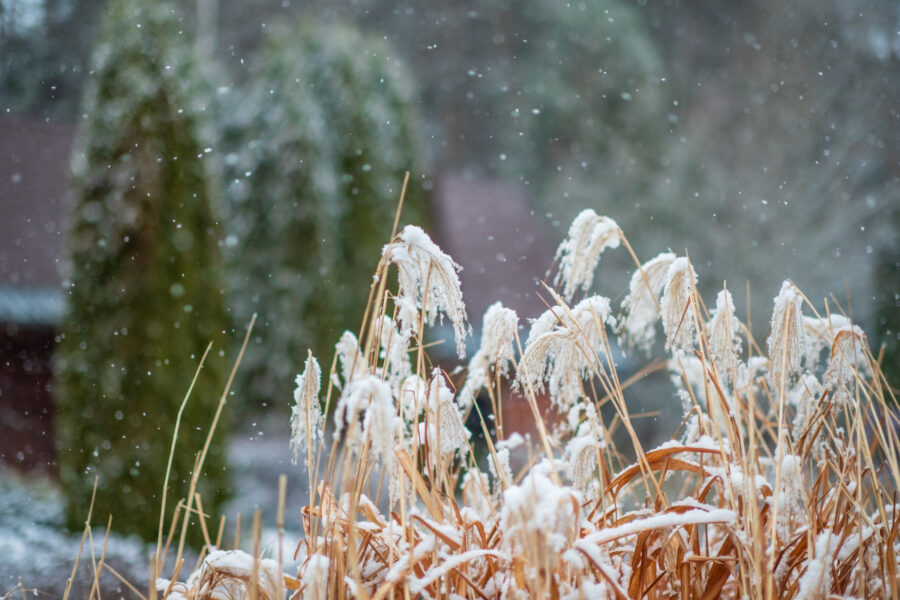
Create a winter wonderland
Climate change is having a ‘flattening’ impact upon our seasons, with one blending almost seamlessly into the next, then possibly back again, down here on the south coast, but at least we have seen fewer frosts in recent years. However, after Mr Frost has visited, the sight of the lawn, ornamental grasses, trees, shrubs and intact perennial remains sparkling with white hoar frost, standing still and silent, is truly magical to behold.
So know that helping soil and sheltering wildlife also has the potential to create a most wonderful winter display over the months ahead.
Mike’s canny cutting back tips
So, when is the best time to get into our gardens and cut down faded perennials?
As always, there are no set rules – it’s your garden and you may have already completed this task, which is fine don’t worry.
I cut back some perennials in November, but only enough to make room for my spring bulbs including daffodils, tulips and pretty dwarf irises. This is because some (including my beloved ornamental grasses), may be brought down by strong winds and heavy rainfall, so they’re cleared away when the weather improves.
Then, during January and February before spring bulbs and perennials start to poke their noses through the soil, I’ll be out there making a start on cutting back. Working by hand helps you to ensure minimum disruption to any sheltering wildlife.
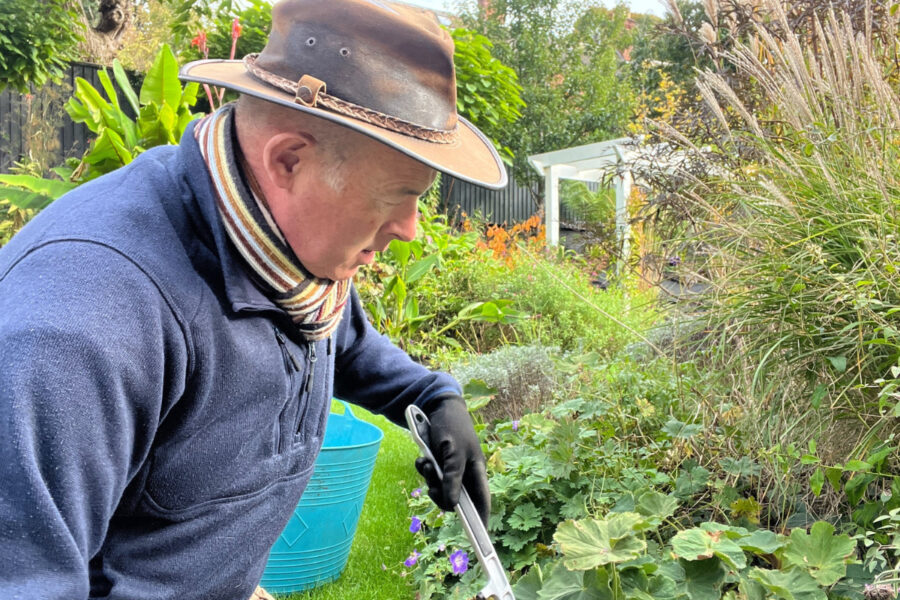
Choose a fine, cold, dry day, grabbing a woolly jumper, hat, scarf, a sturdy pair of waterproof trousers and gardening gloves and a steaming hot cuppa, before setting to work. A kneeling pad can be helpful, and sharp, clean secateurs and shears are vital, alongside a wheelbarrow or large trug to collect the debris, which can be added to the compost heap.
Find more tips, advice and articles like this at the Amateur Gardening website. Subscribe to Amateur Gardening magazine now

